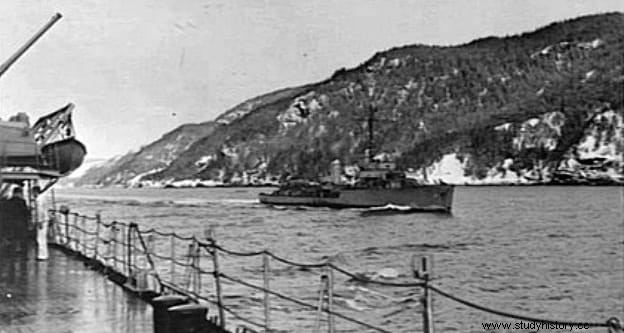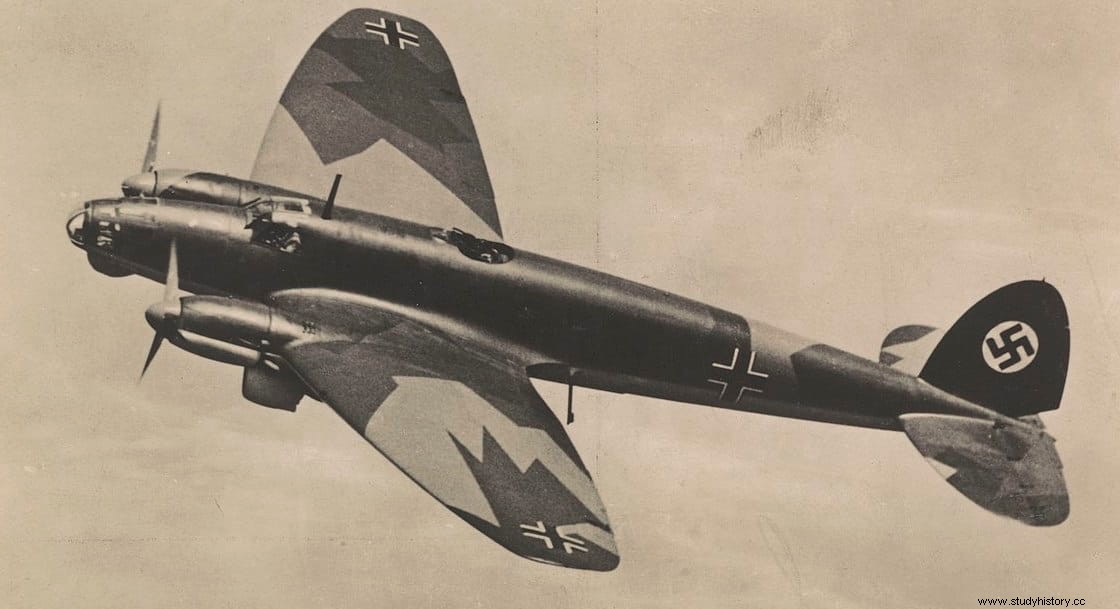“War is too serious a matter to be left in the hands of the military” . The ingenious phrase pronounced by the former prime minister of the French Third Republic, Georges Clemenceau, has come true many times throughout history with fudges such as the charge of the Light Brigade, the landing at the Bay of Pigs, the battle between members of the same army in Karánsebes, etc. Today we are going to look at another lesser-known case that took place during World War II:Operation Wikinger, in which a Luftwaffe plane sank two ships…of the Kriegsmarine.
The tragicomic events took place in February 1940, the same month in which, at the same time, the Soviets launched an offensive against the Finns in their Winter War, Gandhi met with the viceroy of India and, in another order of things, Walt Disney premiered Pinocchio . The setting was the environment of the Dogger Bank, a large sandy bank (17,600 square kilometers) located in the center of the North Sea, a hundred kilometers from the British coast; an important fishing area, rich in cod and herring, which attracted many trawlers to fish in its shallow waters.
The Germans were suspicious of this activity and considered that some of those boats were actually what they called vorpostenboot , that is, reconverted and properly armed advance, merchant or fishing vessels that were used in reconnaissance, escort and minelaying (or guiding their fleet between mined areas). Since the Luftwaffe had also reported the detection of submarines in the area, the high command decided to organize a squad to eliminate the enemy presence there, either sinking the ships or capturing them.

To carry out the operation, baptized with the name of Wikinger (Vikings), six units of the 1st Destroyer Fleet were assigned:Friedrich Eckoldt , Richard Beitzen , Erich Koellner , Leberecht Maass , Max Schulz and Theodor Riedel , all with embarked troops additional to the crews in the face of the possibility of capturing the enemy instead of destroying it. Let's look especially at the last three, because they were going to be the ones affected by the nonsense that awaited them on February 22 and they already had an unflattering record.
The Z1 Leberecht Maass , of the Zerstörer 1934 class, was a ship named in honor of the homonymous rear admiral who fell in the battle of Heligoland, during the First World War. It was the first German destroyer built after the war, launched in Kiel in 1935, participating in the blockade of Poland - during which it was hit by enemy fire, which caused four deaths and as many wounded - and in the hunt for British merchant ships. , in response to the Altmark incident .
His twin was the Z3 Max Schulz , launched the same year as the other and more unlucky. In August 1939 she collided with a torpedo boat, killing two of her men and wounding six; no one was harmed on the destroyer, but she had to be towed to Swinemünde to have her bow repaired; she there she was still when the war broke out. Later, during an anti-smuggling mission, she blew out a turbine, running out of power offshore until she could fix it.

Regarding the Z6 Theodor Riedel , was more modern, launched in 1936, which did not spare it from some incidents:in 1937 it ran aground off Heligoland and suffered a breakdown while mining the British coast, before experiencing one of its worst moments in Operation Wikinger. It did not come off as poorly as its predecessors and was later able to intervene in many actions -although suffering damage-, such as the taking of Trondheim or the Battle of the Barents Sea, until at the end of the war it joined the French Navy, exchanging its name for Kléber .
The normal thing would have been for this combat group to be accompanied by air support, but Hermann Göring, supreme commander of the Luftwaffe, had refused to give up planes to form a Marineflieger, so the German Navy did not have one assigned and depended on the Air Force. He so requested it; however, the Luftwaffe planned its own operation with two squadrons of Heinkel He 111 bombers, belonging to the X Fliegerkorps. It was a body that used to carry out attacks against the British merchant marine since Germany declared it a military objective on February 14, although it also made incursions on its coast.
However, the Kriegsmarine was not informed of the follow-up mission because the Fliegerkorps, operating largely on their own, did not have the reconnaissance capabilities the navy required. At the same time, the planes, which had initially planned a raid on England, were not warned of the presence of the German destroyers because it was feared that the enemy would intercept communications; they had already taken off when the coincidence was known. That lack of coordination was going to be expensive.

The destroyer flotilla sailed from Wilhemshaven Harbor on February 22; It was commanded by Commander Fritz Antz Berger, a Prussian officer who had been at sea since 1917 and had been awarded two Iron Crosses. Ships, with Friedrich Eckoldt As lead ship, they sailed a secret mine-free channel called Westwall for seven miles, though British destroyers Ivanhoe and Intrepid they had managed to undermine its final stretch. However, and despite the fact that the requested aircraft escort did not appear, the sea was calm, the sky was clear and they expected to leave that dangerous area shortly.
Around quarter past seven in the evening one of the Heinkels, belonging to the II Gruppe Kampfgeschwader, flew over the squadron at low altitude. Its crew had barely received training in aerial observation of ships and at first, in the moonlight, they only saw one that they could not identify, taking it for a merchant ship of about four thousand tons. Let us remember that the planes had not been informed of the presence of the destroyers there and since, on the other hand, they had orders to attack only if the opponent was hostile, the pilot of the Heinkel decided to approach. From the Max Schulz They thought they saw the German cross on the wings, but...

The problem was that the signals sent by the ships were not answered, so they took it for an enemy reconnaissance plane and began to fire their anti-aircraft weapons, which was answered with machine gun fire. The Heinkel tacked and then came back, diving astern against the Leberecht Maass to throw four bombs at him. One of them exploded between the bridge and the first funnel, leaving the ship so battered that she had to radio the others for help. They received the order to continue the march while the flagship turned around to come to the aid of the Leberecht Maass . It was a quarter to eight.
The Friedrich Eckoldt it was already less than a hundred and a half meters away when a second pass of the plane hit the Leberecht Maass again. with two bombs, causing a huge explosion that split it in half and scuttled it. Given the shallow depth -about thirty-six meters-, both the bow and the stern emerged above the surface, which facilitated the rescue of the survivors because, in addition -and fortunately-, the Heinkel left without noticing that there were more boats . However, the misfortunes were not over; fifteen minutes later, just after eight in the evening, a new misfortune occurred.
The other ships came to help and the rescue work continued, with the collaboration of Erich Koellner , when another loud detonation was heard. This time it was the turn of Max Schultz , which sank like a stone, but not as a result of an air attack, as there were no planes in sight. At that time there was confusion and the cause was not known, so it was thought that it had been a torpedo; today it is believed that it was a mine, but in the midst of the chaos, with ships lost and dozens of sailors in the water, the destroyers began evasive maneuvers in the face of the possible presence of submarines, leaving only the Erich Koellner .

He then headed towards the site of the sinking of the Max Schultz , but, going at full speed, a boat with castaways that he had managed to tie to the port side capsized and its occupants drowned. The destroyer reached the point at half past eight, just as she raised the anti-submarine alarm again, any flotsam from the wreck was mistaken for a periscope. Following Murphy's law, Theodor Riedel's hasty depth charge launching she caused the shock wave of the blasts to render her rudder temporarily inoperative, sailing in a circle. Finally, after that half hour of chaos, Commander Berger ordered all units to withdraw so that Erich Koellner could operate without hindrance.
It ended at five past nine, already in complete darkness, having picked up only 60 survivors - one of whom died during the return - which meant that 578 sailors had lost their lives, many of them due to the freezing temperature of the water in the half hour lost in searching for submarines; in fact, one more must be added, a member of the crew of Erich Koellner himself. that he died when the stem of the ship rammed the boat from which he was working on the rescue. From Max Schultz no one was saved. The flotilla arrived at the port of Wilhelmshaven throughout that fateful night and the mandatory report was sent in the morning.
A commission of inquiry assembled aboard the cruiser Admiral Hipper concluded that there were never submarines in that area, since it was mined, blaming the events precisely on the mines. In the case of Max Schulz , it was taken for sure; in that of the Leberecht Maass , it is still unknown today whether the coup de grâce was due to a Heinkel bomb, an internal explosion caused by the first, or also a mine. The fact that no officer of either ship survived and that Göring, head of the Luftwaffe, was uncooperative, compounded the reporting difficulties.

In short, the episode resulted in the Kriegsmarine losing its first destroyers in the war, with the disgrace that it had been due to friendly fire. No one was held accountable or held accountable.
